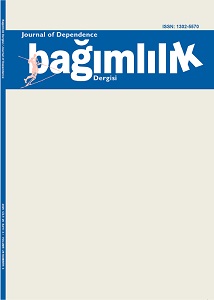RESEARCH OF YOUTH GENDER DİFFERENCES İN TOBACCO CONSUMPTİON İN TURKEY
Keywords:
Tobacco use, gender role, logistic modelsAbstract
Objective: Tobacco habits are one of the major public health problems that are becoming increasingly common among our young people. The purpose of this study is to determine the frequency of tobacco use among male and female aged 15-25 in Turkey and the risk factors that may have an impact on tobacco use.
Method: The study is a descriptive and causal-comparative study. From the Turkish Health Survey questionnaire, cross-sectional data of 3568 male and 4218 female subjects aged 15-25 years were used. Frequency analyzes of tobacco use by young male and female were given, and chi-square independence tests were conducted to determine whether there is a relationship between tobacco use and variables in the questionnaire. All variables were considered together, and two categories of logistic regression analysis were used to determine the risk factors affecting tobacco use in male and female.
Results: 79.3% of male and 87.1% of female who smoke live in urban. The frequency of alcohol use among male and female who smoke was 27.5% and 20.8%, respectively. Male who graduated from university have a higher tendency to smoke than those with the lowest education level (Odds Ratio: 2,86, %95 confidence intervel: 1,71-4,79). Male (Odds Ratio: 5,07, %95 confidence intervel: 3,26-7,88) and female (Odds Ratio: 16,19, %95 confidence inter-vel: 9,62-27,25) exposed to tobacco more than 5 hours a day at home are more likely to smoke than those who are never exposed.
Conclusion: The results of the study show that the effects of risk factors associated with tobacco use are greater in male than in female. Policies to prevent tobacco use need to be given more importance to young people who are exposed to tobacco at home, who use alcohol, and who have a high monthly income.
References
Bassiony MA, Aqil M, Khalili M, et al. Tobacco consumption and oral, pharyngeal and lung cancers. The Open Cancer Journal 2015; 8:1-11.
Bilir N, Aslan D. Dünyada, Türkiye’de ve Hacettepe’de tütün kontrolü çalışmaları. Hacettepe Tıp Dergisi 2005; 36:75-79.
Kaplan B, Özcebe H, Attila S, ve ark. Hacettepe Erişkin Hastanesine başvuran hastaların sigara bırakma hizmetleri hakkındaki yaklaşımlarının değerlendirilmesi. Tüberküloz ve Toraks Dergisi 2013; 61:312-319.
World Health Organization. Global report on trends in prevalence of tobacco smoking 2015. http://apps.who.int/iris/b itstream/10665/156262/1/97892415649 22_eng.pdf (18 Ocak 2017’de ulaşıldı).
Palipudi KM, Gupta PC, Sinha DN, et al. Social determinants of health and tobacco use in thirteen low and middle income countries: evidence from Global Adult Tobacco Survey. PloS one 2012; 7:e33466.
Mackay J, Eriksen MP. The tobacco atlas. 1. Baskı, Geneva: World Health Organization, 2002: 26
World Health Organization. Gender, women, and the tobacco epidemic. http://apps.who. int/iris/bitstream/10665/44342/1/97892415 99511_eng.pdf (15 Kasım 2016’da ulaşıldı).
Ganatra H, Kalia S, Haque A, Khan J. Cigarette smoking among adolescent females in Pakistan. The International Journal of Tuberculosis and Lung Disease 2007; 11:1366-1371.
Khude S, Pawar R, Shivakumar K, et al. Prevalence and pattern of tobacco related habits among the college students of Satara district. Journal of Indian Association of Public Health Dentistry 2015; 13:169.
Jarallah JS, Al-Rubeaan KA, Al-Nuaim ARA, et al. Prevalence and determinants of smoking in three regions of Saudi Arabia. Tob Control 1999; 8:53-56.
Smith DR. A systematic review of tobacco smoking among nursing students. Nurse Education in Practice 2007; 7:293-302.
Güleç M, Bakır B, Özer M, et al. Association between cigarette smoking and depressive symptoms among military medical students in Turkey. Psychiatry Res 2005; 134:281-286.
Açıkel CH, Kılıç S, Uçar M, ve ark. Sağlık Astsubay Meslek Yüksekokulu öğrencilerinde sigara içme durumu ve etki eden faktörler. TSK Koruyucu Hekimlik Bülteni 2004; 3:178-185.
Erdal G, Erdal H, Esengun K, Karakas G. Cigarette consumption habits and related factors among college students in Turkey: A logit model analysis. The Journal of The Pakistan Medical Association 2015; 65:136-141.
Bagheri A, Habshah M, Imon R. A novel collinearity-influential observation diagnostic measure based on a group deletion approach. Communications in Statistics-Simulation and Computation 2012; 41:1379-1396.
Oktay E, Çelik AK, Akbaba Aİ. Examining demographic factors related to cigarette smoking among undergraduate students at a Turkish university. International Journal of Higher Education 2013; 2:175-183.
Kostova D, Andes L, Erguder T, et al. Cigarette prices and smoking prevalence after a tobacco tax increase—Turkey, 2008 and 2012. Morbidity and Mortality Weekly Report 2014; 63:457-461.
Arslanhan S, Caner A, Helvacioglu K, et al. An economic analysis of tobacco elimination policies in Turkey. Health Policy 2012; 106:149-160.
Önder Z. The economics of tobacco in Turkey: new evidence and demand estimates. Economics of Tobacco Control. The World Bank, Washington: Health, Nutrition and Population (HNP) Discussion Paper No. 2, 2002: 24
Öncel SY, Gebizlioğlu ÖL, Alioğlu FA. Risk factors for smoking behavior among university students. Turkish Journal of Medical Sciences 2011; 41:1071-1080.
Grover A. Role of race in influencing smokers’ attitudes and behavior: an explorative study for african-american and white adolescents. Academy of Health Care Management Journal 2010; 6:41-55.
Downloads
Published
How to Cite
Issue
Section
License
Copyright (c) 2025 Journal of Dependence

This work is licensed under a Creative Commons Attribution-NonCommercial-NoDerivatives 4.0 International License.
...
